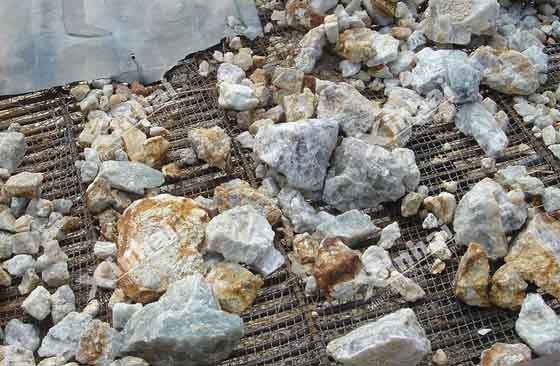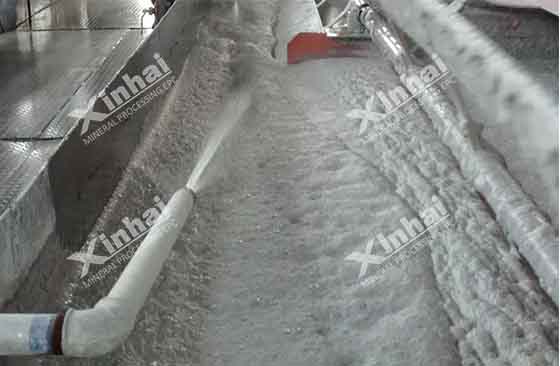

Warm Tip: If you want to know more details about equipment, solutions, etc, please click the button below for free consultation, or leave your requirements!
Fluorite is one of the common non-metallic minerals, the chemical formula is CaF2. It is widely used in metallurgy, chemical engineering, ceramics, glass, casting and other industries. Common fluorite beneficiation methods mainly include manual selection, gravity separation and flotation, among which flotation is the most used. There are 8 main factors affecting the fluorite flotation effect.

In fluorite extraction operation, grinding fineness is one of the most important factors affecting the beneficiation effect, which directly affects the quality of the final concentrate. Through the mineral processing experiment, it is found that within a certain particle size range, the flotation effect of a fluorite mine in Xinjiang shows regular changes with the particle size of the ore. When the particle size is coarse, the recovery rate of fluorite is higher, but the concentrate grade is lower. When the particle size is fine, the recovery rate of fluorite is lower, but the concentrate grade is higher. Therefore, if you want to increase the fluorite recovery rate, you should reduce the grinding particle size, and vice versa.
Fluorite is usually flotation with carboxylic acid collector. Because of the high freezing point of carboxylic acid, pulp temperature has a significant influence on the flotation process. In a certain temperature range, the solubility of carboxylic acid in slurry increases when the temperature is high, and the carboxylic acid is easy to disperse. Therefore, it has strong collection performance for fluorite ore, and its recovery rate is high. However, if the fluorite is not completely dissociated, some gangue minerals will be separated together with the fluorite, which will result in a lower grade of the fluorite ore. When the temperature is low, the carboxylic acid collection performance is weak, but some fluorites with better floatability will be separated. At this time, the concentrate grade is high, but the recovery rate is low.
Under certain conditions, when the amount of collector is large, the recovery rate is high, but the grade is low. Generally, the amount of collector will be increased in roughing flotation to maximize the fluorite recovery rate. When the amount of collector is small, the fluorite recovery rate is low, but the concentrate grade is high. In concentration operation, generally choose to add less or no collector to improve the concentrate grade.

The main function of inhibitors is to inhibit gangue minerals and harmful elements in ores. An inhibitor test of a fluorite mine in Xinjiang showed that when the inhibitor dosage is low, the content of gangue minerals such as calcite and barite in the concentrate is high, resulting in a lower grade of the concentrate product. However, due to the incomplete dissociation of fluorite and gangue minerals in primary grinding, some of the fluorites that adhere to the gangue minerals are separated together, resulting in a higher recovery rate. When the amount of inhibitor is large, the grade is high, but the recovery rate is low. In the concentration process, inhibitors are generally added to improve the grade of concentrate products.
During the flotation process, the fluorite minerals with better floatability preferentially reach the top of the foam layer. When the slurry level is low, the concentrate grade is high, but its recovery rate is low. When the slurry level is higher, the recovery rate is higher, but the ore grade is lower.
Slurry pH has a great influence on the fluorite flotation process. When using oleic acid as collector, the floatability is better when the pH is 8-11. When the pH value is 6, the floatability is also better. For different types of fluorite mines, the floatability of the gangue minerals is also greatly affected by the pH value, which affects the separation effect. For example, fluorite and calcite have better floatability when oleic acid is used as the collector with a pH of 8-9.5.
Studies have shown that Mg2+ will seriously interfere with the flotation of fluorite. When fluorite is collected with oleic acid, the flotation effect is significantly reduced due to the presence of Ca2+ and Mg2+ ions in the water. Therefore, water for flotation fluorite needs to be softened in advance.
Within a certain range of agitation strength, as the agitation strength increases, the react time between the agent and the mineral particles can be accelerated, the flotation time can be reduced, so as to recovery rate and grade of the concentrate product.
The above are the eight factors that affect the fluorite flotation process. In the actual production, the fluorite concentrate with standard quality can be obtained only by controlling the factors well.
If you have other questions or want to consult fluorite processing method and equipment, you can consult online customer service or submit a message, we will contact you as soon as possible.
Last: How to Remove Iron from Quartz?
Next: Caving Mining Method Classification and Characteristics


What Are the Differences Between CIP and CIL?
 11197
11197
 0
0